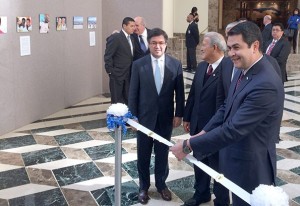[vc_row][vc_column width=”1/1″][vc_column_text]
Outreach center success touted at IADB
By Jillian Slutzker
[/vc_column_text][/vc_column][/vc_row][vc_row][vc_column width=”2/3″][vc_column_text]To tell a story about transformation in the barrios of San Pedro Sula to diplomats, policymakers and business leaders in the corridors of Washington, DC, a picture says a thousand words.
The Inter-American Development Bank showcased images of youth in the Alianza Joven Honduras violence prevention program. The exhibit debuted during a summit of leaders from Central and South America, Europe and the U.S. focused on growth and development in the Northern Triangle region of El Salvador, Guatemala and Honduras.
The 49 vibrant photos on display show youth and the community volunteers, faith-based organizations and leaders who support them in many of the program’s 46 outreach centers in at-risk, high-crime neighborhoods across the country.
“That is my favorite,” said David Medina, Deputy Director of Alianza Joven Honduras, pointing to a photo of eight teenage volunteers jumping in mid-air with their hands raised. “It shows the energy of the volunteers. They are the most important thing in the outreach centers. Because of them, everything happens. It is youth helping youth.”
The Honduran government, through its Security Tax Trust Committee, is contributing $1 million to develop 11 new outreach centers and support all the other centers in Honduras, reaching 23,000 children and youth with additional equipment, prevention activities and support.
Alianza Joven Honduras is funded by the U.S. Agency for International Development and implemented by Creative Associates International.
“A lot of this project we have done together,” said Alejandra Hernández, Honduran Vice Minister of Security in Prevention, discussing the cooperation between the U.S. and her government on violence prevention. “It is important to know it is not just money. It’s really reaching our children.”
Gang violence and narco-trafficking has resulted in Honduras having the highest homicide rate in the world outside of a war zone, and it has been a major source country of unaccompanied minors immigrating to the U.S.
The Alianza Joven outreach centers, which provide at-risk youth with safe spaces and opportunities including life skills, job training, tutoring and volunteer opportunities, are helping to counter these trends, according to a recent study by Vanderbilt University.
 During the summit—which was attended by Presidents Juan Orlando Hernández of Honduras, Otto Pérez Molina of Guatemala and Salvador Sánchez Cerén of El Salvador and U.S. Vice President Joseph Biden—leaders discussed innovative approaches, like the outreach centers, to improve security, health, economic opportunities and education to reduce crime and stem migration from their region.
During the summit—which was attended by Presidents Juan Orlando Hernández of Honduras, Otto Pérez Molina of Guatemala and Salvador Sánchez Cerén of El Salvador and U.S. Vice President Joseph Biden—leaders discussed innovative approaches, like the outreach centers, to improve security, health, economic opportunities and education to reduce crime and stem migration from their region.
“A peaceful Central America, with opportunities for its people, with justice and security, will be of great benefit not only for our citizens but also for the United States and other peoples of the world,” said President Hernández, speaking at the event.
Surrounded by flashing cameras, President Hernandez made a special visit to open the exhibit in between event sessions. The President and First Lady have been vocal supporters of youth-focused crime prevention and the USAID outreach center partnership.
Violence has many causes and is a complex phenomenon in the country, explained Alejandra Hernández, Vice Minister of Security in Prevention as she toured the exhibit.
She said it is important for partners and donors in the U.S. and from outside of Honduras to know that Honduras is not just fighting crime through the criminal justice system. The smiling faces on display in the hall of the Inter-American Development Bank attest to this.
“Prevention is the most important thing,” she said.[/vc_column_text][/vc_column][vc_column width=”1/12″][/vc_column][vc_column width=”1/4″][vc_widget_sidebar sidebar_id=”sidebar-primary”][/vc_column][/vc_row]